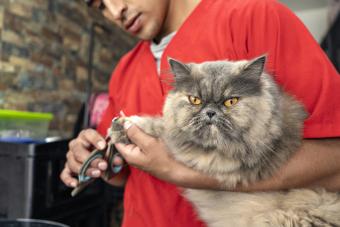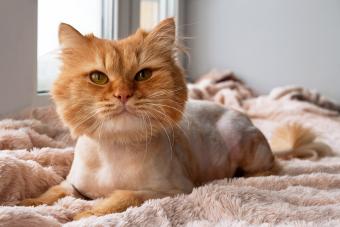
Even though cats are generally self-cleaning creatures, there may come a time when yours needs a haircut. But shaving a cat is not something you should do at home. A cat's skin is much more elastic than a dog's, so a lot can go wrong if you attempt this yourself. Knowing what to expect from the groomer or your vet's office when you bring your cat in for a shave can help you prepare and provide your kitty with exactly what they need.
Scenarios When Shaving Is a Good Idea
The truth is that most cats never need their hair shaved. Even so, there are a few situations where a partial or even full shave could be medically recommended to provide your cat with relief.
- They’ve developed very matted fur that can't be brushed out.
- The hair around their bottom keeps getting soiled.
- They have a severe flea infestation.
- They’re slipping and need the hair between their toes shaved.
- They have a hotspot.
Shaving your cat won't actually keep them cool in the summer. In fact, it can negatively impact their ability to regulate their temperature, and it puts them at risk for sunburn.
When to Leave It to Your Veterinarian
Groomers can help with light or moderate matting, but there are times when you need a veterinarian. This is especially important if you see wounds or abrasions under the mats or if your cat is stressed or aggressive. Your groomer can happily refer you to a vet, or you can head right there yourself in these scenarios.

- Your cat's fur is heavily matted, and the mats extend to the skin
- The skin beneath a mat is bloody or appears infected
- You accidentally cut your cat during a shave
- Your cat is extremely agitated and unable to be calmed or restrained enough to clip them safely
Many Cat Shaves Need Sedation
Even if your cat is generally gentle and sweet, your veterinarian may recommend sedating or even anesthetizing them for their shave. This could be because the mats are painful and tugging at the skin or because they're squirmy, and there's a risk of cutting the skin if your cat moves. Whatever the case, your vet will recommend the best approach for your cat based on their health.
Related: Important Dos & Don'ts for Getting Mats Out of Cat Fur
How Groomers Shave a Cat
When you take your cat to a groomer to have them shaved, keep in mind that every cat is different. Some will resist shaving more than others. Depending on your groomer and the facility they work out of, they may allow you to hold your cat during the shave. If that's the case, you can use these tips to help your cat receive a safe and comfortable shave.

1. Trim Their Nails First
Many cats will try to defend themselves when being shaved. Play it safe, and clip their claws before you take them to be shaved or ask your groomer to trim them.
2. Test the Sound
Your groomer will test the sound of the clippers near your cat. If your cat becomes very fearful at only the sound, you may want to consider using a harness or restraining device or asking your vet for a mild sedative before you begin.
3. Hold the Skin Taut
Cats have very flexible, pliable skin that moves easily. This means that it can easily bunch up under the clippers, potentially giving them a pinch or cut. Your groomer will hold the skin down firmly, pulling it taut as they shave to avoid cuts.
They always use extra caution around the armpits, groin, elbow, and knee areas where the skin tends to naturally wrinkle, and they're always especially careful when shaving senior kitties because older cats tend to have more fragile skin.
4. Shave Tip to Tail
If you're able to assist your groomer, you'll want to hold your cat gently but firmly as they work their way around their body, starting towards the back of the neck and working their way towards the tail.
5. Check the Blade Temperature
Clippers heat up quickly, so they'll check the temperature of the blade frequently throughout the shave. To do this, they just press the clippers against the top of their hand. If they're too warm, your groomer will change out the blade or use a cooling clipper spray to bring the temp down, as hot clippers could burn your cat if they come in contact with their skin.
6. Take Frequent Breaks
The key to a successful shave is to take your time. The more calm and unhurried the actions are, the calmer your cat will be. Your groomer will work slowly to avoid cutting the skin and take breaks if they or you feel your cat is becoming too agitated to continue.
It may take several shaves before your cat realizes this procedure won't harm them, and they can finally relax while your groomer works. Try to keep from frightening your cat more than necessary to build this trust in the long term.
Speak soothingly to your cat and give them plenty of pets throughout the process to reassure them. It can be helpful to have one person at the head simply stroking the cat's head while your groomer clips.
How to Shave a Cat With Mats
One of the most common scenarios when you'll find yourself going to the groomer to shave your cat is if they develop mats. Matted fur happens when the shedding undercoat gets stuck in a cat's top coat or if they're not able to groom themselves. If you find a few of these knots, the groomer can easily shave them with these steps.
- Your groomer will hold the matted fur by its end and gently move it from side to side as they shave around and under it.
- Depending on how close the mat is to the skin, they may be able to reach it better from one angle or from multiple angles.
- They'll keep moving it gently and cutting it slowly until it comes free.
- If you're able to assist your groomer, they may have you act as a helper to pull the skin around it flat to avoid it coming up into the mat and getting cut.
Can I Shave My Cat?
No, you should not shave your cat at home. The key to safe cat shaving is having it done by a professional. However, regular and frequent grooming can help prevent mats and the need to shave your cat. Practice proper grooming, like brushing, to help avoid this unpleasant task, and if shaving does become necessary, see your groomer or veterinarian.






